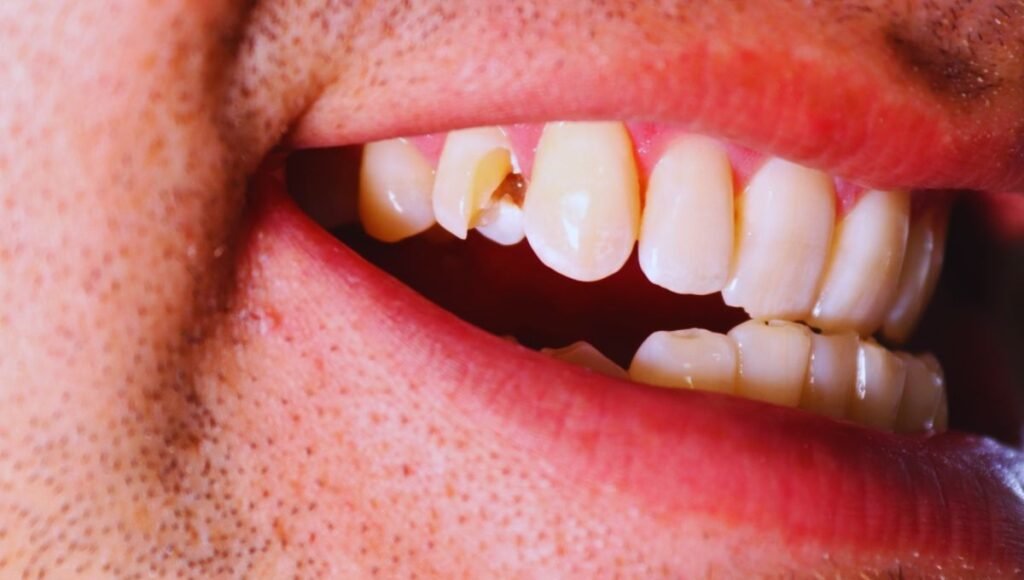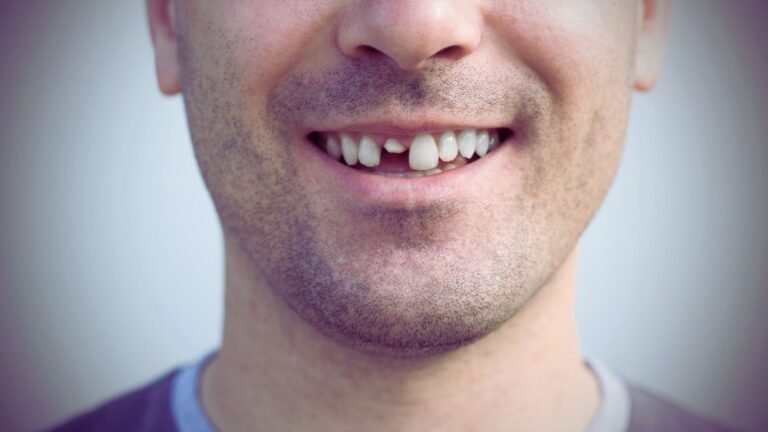How to Get Rid of Pain From a Broken Tooth?
Dealing with a broken tooth can be incredibly painful, and you’re likely seeking immediate relief to manage the discomfort. First, you should use a cold compress on the area to reduce swelling and numb the pain temporarily. It’s also beneficial to rinse your mouth with salt water to prevent infection. However, these are just preliminary steps.
To fully address the pain and avoid further complications, there are several effective methods you can utilize. But what if there was a specific technique that not only alleviated the pain quickly but also helped in the healing process? Let’s explore some essential tips that might surprise you.
Identifying a Broken Tooth

Often, you’ll first notice a broken tooth by a sharp, localized pain when you bite down or touch the affected area. This discomfort is one of the primary symptoms of a broken tooth, indicating that the structural integrity of the tooth has been compromised.
Besides pain, other symptoms might include sensitivity to hot or cold temperatures, and sometimes an exposed nerve can cause a severe, pulsating pain. Additionally, the edge of the broken tooth might feel rough to your tongue, and there may be visible damage or discoloration.
Several factors contribute to broken tooth causes. Trauma to the mouth, such as a blow or fall, commonly results in a fractured tooth. Dental decay can weaken teeth, making them more susceptible to breaking even under normal chewing forces. In some cases, old, large amalgam fillings that don’t support the remaining enamel structure can also lead to a tooth breaking.
Understanding these causes and symptoms is essential for seeking timely dental care. Ignoring these signs can lead to further complications, such as infection or more severe damage. Hence, recognizing the indications of a broken tooth prompts necessary preventive measures and treatment.
Immediate Pain Relief Tips
If you’re experiencing pain from a broken tooth, applying a cold compress to the affected cheek can swiftly reduce swelling and alleviate discomfort. Immediate relief is vital, not only for comfort but also to prevent further complications.
Here’s a concise guide to managing your pain before you can receive professional treatment:
- Cold Compress: Apply an ice pack wrapped in a towel to the affected area for 15-20 minutes every hour. This helps numb the pain and reduce inflammation by constricting blood vessels.
- Salt Water Rinse: Mix 1/2 teaspoon of salt in a cup of warm water and swish gently around the affected area. This can cleanse the area, dislodging any food particles and reducing the risk of infection.
- Temporary Filling: If the broken tooth has a sharp edge or a significant missing piece, consider using a temporary dental filling material, available at most pharmacies. This can cover the exposed area and reduce irritation to the nerve until you can obtain emergency dental care.
Safe Use of Pain Medications
While managing pain from a broken tooth, it’s vital to use pain medications responsibly to avoid potential side effects and guarantee effectiveness. For optimal pain management, adhering to prescribed dosage guidelines is essential. Over-the-counter (OTC) options such as acetaminophen or ibuprofen can be effective, but you must follow the recommended dosages to prevent adverse effects like gastrointestinal issues or liver damage.
Ibuprofen, a nonsteroidal anti-inflammatory drug (NSAID), not only reduces pain but also diminishes inflammation, making it a preferred choice for dental pain. However, it’s important to take no more than 3200 mg per day to minimize the risk of renal impairment or peptic ulcers.
Acetaminophen, alternatively, is suitable for those who prefer a non-NSAID option. It’s crucial to keep the daily intake below 3000 mg to avoid hepatotoxicity, a severe liver condition.
Always check if the medication interacts with any other treatments you’re currently taking. For instance, combining NSAIDs with certain anticoagulants can increase bleeding risks, which is particularly vital to consider in dental scenarios.
Consulting with a healthcare provider before beginning any new medication regimen ensures safe and effective pain management, tailoring treatment to your specific health profile and needs.
Home Remedies to Consider

Besides following prescribed medication guidelines, exploring home remedies can provide additional relief from the discomfort of a broken tooth. These natural remedies are particularly useful as emergency care measures until you can receive professional dental treatment.
Here are a few methods you might consider:
- Cold Compress: Applying a cold compress to the affected area can significantly reduce swelling and numb the pain. It’s important to wrap the ice in a cloth to avoid direct contact with your skin, which can cause tissue damage. Apply the compress for 15-20 minutes every hour as needed.
- Salt Water Rinse: A saline solution can help clean the oral cavity and reduce the risk of infection. Dissolve a teaspoon of salt in a cup of warm water and gently swish it around your mouth for 30 seconds. This can be repeated several times a day to alleviate pain and promote healing.
- Clove Oil: Eugenol, found in clove oil, has analgesic and antiseptic properties. Apply a small amount of clove oil directly to the affected tooth using a cotton swab. This can provide temporary pain relief and help manage infection risks.
These methods shouldn’t replace professional medical advice or delay seeking dental attention, especially if your symptoms persist or worsen.
When to See a Dentist
You should consult a dentist immediately if you experience severe pain, persistent symptoms, or visible signs of infection from a broken tooth. These are clear indicators that the damage may involve more than the visible structures and potentially affect deeper tissues or the tooth’s pulp. Waiting too long can worsen the issue, leading to more complex procedures later.
In emergency situations, it’s important to understand the extent of coverage provided by your dental insurance. Most plans differentiate between routine care and emergency interventions, often handling them under separate benefit structures. Familiarize yourself with the terms of your policy to make sure you can access immediate care without unexpected expenses.
If you notice swelling, pus, or fever, these are signs of an infection that requires prompt professional treatment to prevent spread to adjacent teeth or systemic involvement. Additionally, if the pain disrupts your daily activities or sleep patterns, it’s a signal that the dental pulp might be compromised.
Always keep your dentist’s emergency contact information accessible and discuss potential after-hours services during your visits. Managing a broken tooth effectively involves timely assessment and intervention by dental professionals. Don’t hesitate to seek their expertise to alleviate pain and prevent further complications.
Preventing Future Dental Injuries
To prevent future dental injuries, it’s vital to adopt effective protective measures during both everyday activities and sports. Understanding how to shield your teeth can save you from painful and costly dental procedures.
Here are three important steps you can take:
- Wear Protective Mouthguards: The benefits of mouthguards are significant, especially in contact sports. A well-fitted mouthguard can absorb and disperse the impact that might otherwise cause broken teeth, jaw injuries, or concussions. It’s crucial to choose a mouthguard that’s comfortable, durable, and properly fitted to guarantee maximum protection.
- Maintain Rigorous Dental Hygiene: Implementing thorough dental hygiene strategies is essential. This includes brushing at least twice a day with fluoride toothpaste, flossing daily, and using an antiseptic mouthwash to reduce the bacterial load in your mouth. Regular dental check-ups allow for early detection and prevention of potential dental issues.
- Use Proper Techniques in Sports and Eating: Avoid using your teeth to open containers or bite hard objects. During sports, practice techniques that minimize risk to your face and mouth. Always use appropriate face masks or helmets designed to safeguard dental structures.
Frequently Asked Questions
Can a Broken Tooth Lead to Other Health Complications?
Yes, a broken tooth can lead to dental infections and other complications if not treated. Proper pain management and treatment are essential to prevent further health issues. Always consult a dentist for guidance.
How Does Age Affect the Healing Process of a Broken Tooth?
Age influences your tooth’s healing time notably. Children’s teeth often repair faster due to robust regenerative capabilities, contrasting with adults, especially the elderly, who might experience slower healing and require more intensive dental care.
Are There Specific Foods to Avoid During Recovery?
You should avoid hard, crunchy, or sticky foods to facilitate your healing process. Opt for a soft diet to minimize strain and promote recovery during the sensitive period following a dental injury.
Is It Safe to Exercise After Breaking a Tooth?
You can exercise after a dental emergency, but take precautions. Avoid high-impact activities that may exacerbate your condition. Opt for gentle exercises and consult your dentist to tailor your physical activity safely.
How Can Emotional Stress Impact Tooth Health and Recovery?
Emotional stress can hinder your tooth’s recovery by exacerbating inflammation and delaying healing. Stress management is important for your emotional well-being, promoting faster healing and reducing complications in dental health restoration.
Conclusion
To alleviate pain from a broken tooth, promptly apply a cold compress and rinse with saline solution. Employing a temporary filling can offer temporary relief.
For pain management, judiciously use recommended analgesics. However, these measures are interim; consult your dentist promptly to address the underlying issue and prevent further complications.
Maintaining good oral hygiene and using protective gear during sports can help prevent future dental injuries. Always prioritize professional dental care for best health.
